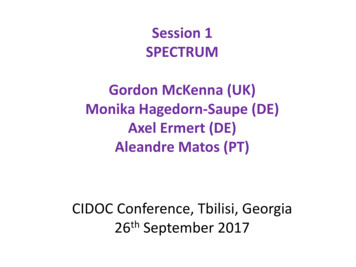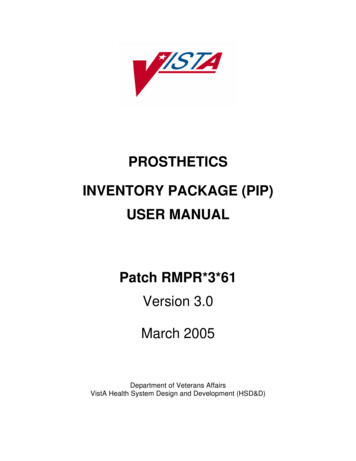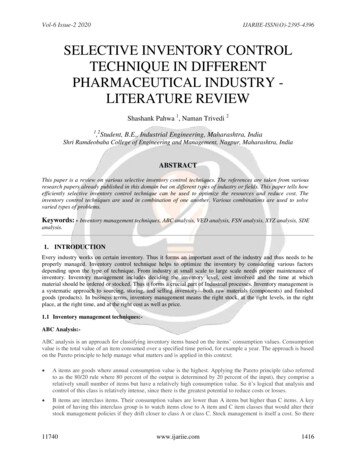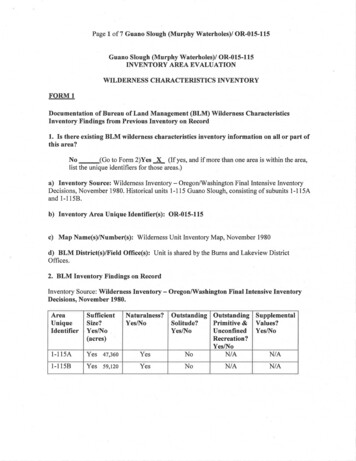
Transcription
Report From TheSpectrum Inventory Working GroupOf TheCommerce Spectrum Management Advisory CommitteeMichael CalabreseMarty CooperMark CrosbyGary EpsteinRobert GurssMark McHenryDarrin MyletJennifer WarrenMay 19, 20101
Table of ContentsIntroductionWorking Group AdviceQuestions and AnswersBackground InformationFundingFuture ConsiderationsConclusionAppendix A – Spectrum Inventory ElementsAppendix B – Use of Spectrum Measurements2. 3. 3. 5. 8. 9. 10. 10. 11. 13
Spectrum Inventory Working GroupCommerce Spectrum Management Advisory CommitteeIntroductionThe demand for new telecommunications spectrum is increasing exponentially, and this growth isexpected to continue indefinitely. Any solution to spectrum scarcity that relies alone on theredistribution of a fixed amount of spectrum is, in the long term, a strategy that will not succeed.Ultimately, most services will continue to experience increased demand, and pitting one service againstanother will become a zero-sum game. The purpose of an inventory should be to add to the policymaker’s toolkit in efforts to enable and promote more intensive use of existing allocations andassignments, rather than solely for the reallocation or repurposing of spectrum. Even if some spectrumis repurposed, industry or government users should be encouraged to deploy known and provenmethods for increasing spectral efficiency or effectiveness of use. For example, data compression,smart antenna, MIMO, and new emerging sharing technologies will allow existing spectrum holders toenhance spectrum capacity and manage growth without the need for additional spectrum assets. Insome cases, these techniques may create new spectrum access opportunities, if spectrum sharing isproven to be technically feasible and does not undercut a spectrum holder’s ability to manage futuregrowth. Spectrum gained through such capabilities is an important long-term, sustainable solution tofulfilling exponential spectrum demand by existing holders and, in some instances, new services.In addition to this overriding point and the other suggestions that follow in this paper, the SpectrumInventory Working Group nevertheless agrees that there are substantial benefits that would result fromthe creation of an automated and accessible Spectrum Inventory.The FCC previously soughtinformation in its initial Notice of Inquiry (NOI) on the National Broadband Plan,1 and commentersresponded positively to the NOI’s questions on whether and how the Commission should conduct a“spectrum census” or “spectrum inventory”2.Working Group AdviceThe Commerce Spectrum Management Advisory Committee (CSMAC) Spectrum Inventory WorkingGroup (SIWG) has been tasked with answering a number of questions that will provide policy advice toNTIA regarding the development of a Spectrum Inventory. These questions are addressed below. Inaddition, the working group has the following general comments regarding the two pending SpectrumInventory bills. (For background on the Spectrum Inventory Acts, please see the end of this document.)Carrier, public safety and business enterprise demand for spectrum for land mobile services in heavilypopulated areas is increasing rapidly. Furthermore, the mobile wireless industry has articulated a needfor additional spectrum to support broadband wireless services, while the Federal Government has alsoarticulated increasing demand for bandwidth intensive capabilities (e.g., UAV, radar), both civil and1A National Broadband Plan for Our Future, Notice of Inquiry, GN Docket No. 09-51, 24 FCC Rcd 4342 (2009) (NOI).2NOI at ¶ 44. See, e.g., Comments of New America Foundation et al. at 15-30, Google at 16, Dell at 11-12,Southern Company at 6-12, Computer & Communications Industry Association at 22, Motorola at 9, Intel at 20,Rural Telecommunications Group at 4, Wireless Internet Service Providers Assoc. at 17, and T-Mobile at 16.3
military. The plans to review both federal and non-federal spectrum holdings may provide a betterunderstanding of the possible options to address these needs. Potential results may include: Redistribution of existing spectrum assignments from entities that are not using their entirespectrum; Encouragement of capacity-enhancing techniques for existing spectrum holders to permit themto manage future growth and curtail the need for additional spectrum assets; Introduction of spectrum sharing technologies in specific frequency bands so that underusedspectrum can be shared between compatible, non-interfering uses in those cases where sharingis determined to be technically feasible and where it will not undercut the existing spectrumholder’s ability to manage future growth.Concerning the first approach, we respectfully suggest that the fundamental precept of redistributionneeds to be challenged. Redistribution is not the only option for the long-term need for spectrum. Theeffective size of the spectrum is not fixed and unchanging. There has been a continual growth in theneed for spectrum since radio technology was created more than 100 years ago. As new services havecreated new demands for spectrum, technology has increased the capacity of the spectrum toaccommodate these new demands. Particularly in the context of fixed and mobile wirelesscommunications, technological innovation allows capacity to stay ahead of demand by enabling greateruse of the same amount of assigned spectrum at a faster rate than the assigned spectrum becamecongested.For example, when cellular communication was introduced in 1983, cellular systems effected animmediate 10 times or greater increase in spectrum availability -compared to the previous techniquesused for mobile communications (30 MHz of spectrum was allocated to cellular communications in 1983but had an equivalent capacity of 300 MHz). Within five years, a new generation of digital-cellularsystems provided at least three times more capacity. Today, cellular systems are more than 100 timesmore efficient than the mobile telephones of the 1980s.And yet demand for spectrum continues to grow. New applications in commercial wireless sector alonehave the potential to increase demand by a factor of at least two or three within the next ten years. Thisdoes not take into account federal or other non-federal growth in spectrum requirements. Withoutcreating any new spectrum access opportunities through new spectrum efficient, sharing or othertechnologies, there would be an unmet demand for an additional 2500 to 5000 MHz of spectrum.Obviously, existing spectrum cannot fulfill current demands of industry and the federal government. Butmuch of the new technology required to enhance the efficient use of existing spectrum to address thisdemand already exists and is in various stages of testing. The communications industry is beginning theimplementation of a new generation of cellular technology that incorporates smart antennas, Internetprotocol, and other new techniques for content compression. Over the next 10 to 20 years, these newtechnologies will effectively multiply existing cellular-communications spectrum allocations by at leastan additional 10 times. This is the equivalent of finding an additional 2500 MHz of spectrum for mobilewireless use. However, this type of insight, valuable to policy makers, is not the result of an inventory;rather, the inventory will yield a baseline on spectrum holdings in the federal and non-federal spectrumbands reviewed.4
But to encourage this greater intensity of use, it is crucial that regulators consider whether licenseesshould be obliged to use advanced techniques to increase spectrum capacity. Consequently, thespectrum-audit process must include not only an analysis of who has a license to what spectrum, butalso an understanding of what that spectrum is being used for. We understand that measurement ofspectrum efficiency is difficult and that different measurements are necessary for different services. Butmeasurement of spectrum efficiency in land mobile services (including cellular services) is achievablewith known techniques that can, in fact, identify potential solutions for improved spectral efficiency inthat service.Achieving a useful spectrum inventory should be a goal for both the FCC and NTIA. A useful inventorywould: Create a navigable database that is accessible to the public and outlines the holders offrequency assignments/licenses in what spectrum bands, where, and for what types of service –however, the degree of transparency of an NTIA database is addressed in a separate workinggroup’s set of recommendations; and As appropriate for the type of services, identify areas of the country and times of the day whenpeak usage results in poor service or when services cannot be implemented.The results of the inventories can then inform policymakers as to the consequences as they considerwhat options are available to them, including requirements for the use of better technology forimproved spectral efficiency, spectrum sharing opportunities, or the allocation of additional spectrum.While this may not apply to spectrum being used for non-communications services, identification ofpotential opportunities for existing spectrum holders to make more efficient use of their spectrumassets through capacity enhancing techniques should be encouraged. In addition, spectrum sharing inareas of the country (e.g., underserved rural) and times of the day where and when assigned spectrum isunoccupied and potentially available to entities introducing non-interfering services, systems or devicesmay result. Of course, spectrum sharing should not be deployed if it detracts from existing spectrumholders’ ability to manage future growth and deploy new and innovative services, or if it creates anunacceptable level of interference that degrades service offerings.In this way, we suggest that the government create and implement policy and regulations that stimulateand encourage uses that benefit the national interest (rather than trying to legislate technologies orservices), and create an environment that stimulates the most effective use of radio frequencyspectrum.Questions and Answers1. What information is needed from a spectrum inventory to reach policy decisions?Answer – We recommend that the public portions of the FCC and NTIA inventories being beavailable through a common portal. We also recommend that the inventories be a commonformat for ease of use, common data standards to facilitate exchange of information betweenthe agencies. They should also contain, to the extent consistent with the Transparency WGrecommendations, information on:frequency assignments, geographic coverage ofassignments, use, international coordination requirements, harmonization of frequencies, HostNation Agreements. In the cases of government or critical infrastructure(CI) licenses, care must5
be taken to balance the benefits of providing public access to the inventories against anypotential problems that could arise from revealing strategic geographic or functionalinformation that could compromise national or CI energy and water system security.Enabling access to the available allocation and assignment databases from the NTIA and FCCthrough a single, unified portal would provide the public, innovators, Congress and the agencies’themselves with a much better understanding of spectrum usage. However, it may also beimportant to supplement this data with all available information regarding the actual use of thespectrum to the extent that creating and sustaining such a database is useful and feasible. Anumber of spectrum occupancy studies have been conducted over the last few years thatdocument the actual utilization of LMR spectrum in certain frequency bands. For example, theFCC’s Enforcement Bureau, NTIA’s Institute for Telecommunication Sciences, academicinstitutions (with the support of the National Science Foundation) and individual companieshave measured spectrum use with interesting, but incomplete results.3NTIA and the FCC should continue their efforts to study the extent to which each frequencyband is being utilized. As would be required by the pending legislation, the agencies andspectrum licensees should, based on available or new data, analyze and disclose appropriatemetrics that provide information on their usage of the their spectrum.NTIA personnel should be able to see how Government spectrum resources are used/un-usedanywhere in the country, down to the “County” level. By knowing if and where any frequencyassignments are under-utilized, alternative uses can be explored. This information should bevisible to anyone via a web viewer.The cost of creating and sustaining a comprehensive infrastructure measurement and databasewould be substantial and would offer minimal benefit. The actual usage of the spectrum ishighly varied with regard to service, technology, and a myriad of other factors. A comprehensivemeasurement system would not be achievable within reasonable time and budget limitations.Specific to the NTIA and the agencies it serves, the assignment of spectrum either permanent oron-demand should be quantifiable and qualified down to the specific frequency, channel sizeand geography at a date certain. The format of an inventory should be designed by NTIA toimprove its ability to see how Federal spectrum resources are used/un-used anywhere in the3For NTIA spectrum occupancy reports, see, e.g., John E. Carroll, J. Randy Hoffman, Robert J. Matheson,“Measurements to Characterize Land Mobile Channel Occupancy for Federal Bands 162–174 MHz and 406–420MHz in the Denver, CO Area,” NTIA Report TR-08-455, September 2008, available online athttp://www.its.bldrdoc.gov/pub/ntia-rpt/08-455/; J. Randy Hoffman, Robert J. Matheson, Roger A. Dalke,“Measurements to Characterize Land Mobile Channel Occupancy for Federal Bands 162–174 MHz and 406–420MHz in the Washington, D.C., Area,” NTIA Report TR-07-448, July 2007, available online athttp://www.its.bldrdoc.gov/pub/ntia-rpt/07-448/. See also FCC Spectrum Policy Task Force, Report of inalReport 1.pdf; R. Bacchus, A. Fertner, C. Hood, D. Roberson, “Long-term,wide-band spectral monitoring in support of Dynamic Spectrum Access Networks at the IIT SpectrumObservatory”, in proceedings of IEEE DySPAN, Chicago, IL, October 2008, available online athttp://www.cs.iit.edu/ wincomweb/publications.html; Shared Spectrum Company Reports available athttp://www.sharedspectrum.com/measurements/.6
United States of America down to the “County” level, if not more specific by contour. Byknowing both the geography and the frequency span, NTIA will be able to see if there is anyfallow spectrum assigned to a Federal agency, why it is fallow, and determine how and why itmight be used either temporarily or permanently by another Federal or non-federal user.Further, the same policy should apply to all FCC commercially assigned; auctioned spectrumshould also be viewable with similar ease, but to the public via a web viewer.The NTIA should endeavor to see these capabilities and determine within a short time framehow to implement this capability rapidly and cost-effectively, consistent with therecommendations on transparency provided by the Transparency Working Group.While it is now neither economically or technically feasible to measure actual spectrum use in allbands, for all times, and over the entire country, the Working Group suggests that selectedactual measurements can have value in spot checking of the data base and to provide usefuldata for those engaged in promulgating and creating spectrally efficient technology. At sometime in the future, it may be practical to measure spectrum use. (See Appendix B, Potential Useof Spectrum Measurements)Spectrum usage and assignment data will likely be very helpful for purposes of fulfilling theagencies’ overall spectrum management duties and responsibilities to ensure effective spectrummanagement.2. What do technology innovators need? For example, do groups seeking access to spectrum needinformation about system characteristics?Answer – We recommend that NTIA, and the FCC through the NTIA, undertake to determinewhat information regarding existing and planned system characteristics, receiver information(ability to reject interference) and duty-cycle information (near-constant transmission orintermittent use), in addition to relevant transmitter locations, emitted power and transmitmasks, can be made available in any public inventory.We recommend that system characteristics for licensed spectrum should include, among others,the number and location of authorized sites, power levels, transmitter technology, spectrumbandwidths, NTIA frequency assignment/FCC application-volume trends, whether the spectrumis used for national-security or public-safety purposes, and, for unlicensed bands, the number ofmanufacturers that have received type-acceptance (FCC approval of a company’s type ofequipment) for products used within the specific band. We also recommend that licenseesverify annually their location and actual use of the spectrum for which they are licensed.NTIA and the FCC should examine the system characteristics list to determine which items ofinformation could potentially reveal sensitive operational or security aspects of government orCI energy and water licensees. This examination should particularly focus on characteristics thatrelate directly to mission-critical functions. In some cases, NTIA and the FCC might need tocoordinate with other government agencies, such as the Department of Homeland Security orthe Department of Energy, to ensure that the inventory does not reveal licensing characteristicsthat jeopardize the security of certain government or CI energy and water mission criticalfunctions.7
We further recommend that each agency seek information from their respective licensees onany spectrum assigned for planned systems or systems in development by federal, state andlocal agencies that would include a synopsis of the system or equipment to be deployed and theassociated timeframe. An analysis of current systems, system/mission life, and applicationmight also be useful. This set of information should be viewable by those within NTIA and FCCwith appropriate security clearance for analysis of their respective license holders.Today, many public-safety organizations, utilities, municipalities, Internet-service providers (toname a few) lack the “spectrum” resources to bring new and urgent data communications totheir current and/or future subscribers. Identification of, and exploration of “inventive” accessto, any un-used assignments or allocations is not only logical but should be a key priority at boththe FCC and NTIA.A comprehensive list of technical characteristics that could be useful to technologies and groupsseeking access to spectrum appears in Appendix A entitled “Illustrative List of SpectrumInventory Elements”. This list needs to take into account that there are terrestrial, aeronautical,maritime, and space-based uses that will have different, but relevant technical characteristicsthat impact use of the assigned or allocated spectrum. For example, list should clearly includerequirements for unique satellite elements, such as two-degree spacing, dual polarization, andspatial separation. This list, which is illustrative, includes regulatory, administrative andtechnical information.3. How can the inventory process be conducted in as timely, cost-effective, and efficient a manneras possible?Answer – We recommend that NTIA, and through NTIA to the FCC, that each agency seekfederal appropriations to support the development of their respective databases/inventories;however, each database should be based on a common data format, standards, so thatinformation can be easily exchanged between the agencies.Background InformationBoth the House and the Senate have introduced legislation entitled the “Radio Spectrum Inventory Act”which would, if enacted, require an “inventory of radio spectrum bands managed by the NationalTelecommunications and Information Administration and the Federal Communications Commission.”The Senate bill (S.649) was introduced on March 19, 2009; and the House bill (H.R. 3125) was introducedon July 8, 2009. The House version provides a broad strategic objective, specifically to “promote theefficient use of the electromagnetic spectrum”, while the Senate version remains silent as to thepurpose of the legislation. These pieces of legislation are virtually identical, including among otherrequirements, the following: Within 180 days, create an inventory of radio spectrum band managed by the NationalTelecommunications and Information Administration (NTIA) and the Federal CommunicationsCommission (FCC); Identify the radio services authorized to operate in each band and provide the identity of thelicensees and government users;8
Provide the total amount of spectrum, by band of frequencies, allocated to each Federal or nonFederal user in percentage terms and in sum, and the geographic areas covered by therespective allocations; Provide the approximate number of transmitters, repeaters, end-user terminals or receivers, orother radio-frequency devices authorized to operate, as appropriate to characterize the extentof use of each radio service in each band of frequencies; For non-Federal users, any commercial names under which facilities-based service is offered tothe public using the spectrum of the non-Federal user, including where the spectrum is beingoffered via resale and under what commercial names; Provide, to the greatest extent possible contour maps or other information that illustratescoverage areas, receiver performance; other parameters relevant to an assessment of theavailability of spectrum in each band; for each band or range of frequencies, the identity of eachentity offering unlicensed services; and the types and general number of unlicensed intentionalradiators or radiators certified by the Commission that are authorized to operate; and Create a centralized portal or website to make the inventory of the bands of frequenciesavailable to the public via an Internet-accessible website.The legislation differs in the scope of the spectrum inventory and the definition of what information maybe excluded in the inventory. The NTIA and the FCC would be required to do an inventory of spectrumbetween 225 MHz and 3.7 GHz, under H.R. 3125 approved on a unanimous vote of the HouseCommunications Subcommittee. Chairman Rick Boucher, D-Va., submitted an Amendment in the Natureof a Substitute to H.R. 3125, which was unanimously voted out of the House Subcommittee on January21, 2010. The mandatory range was reduced to 3.7 GHz and the required report to Congress on theresults of the inventory is to include a “recommendation of which spectrum, if any, should be madeavailable for reallocation” or shared access, not just reallocation. Further, this legislation was modifiedto provide the agencies a year to do the inventory, up from six months in the original bill, and wouldrequire the report to Congress every two years rather than annually. The reduction in the upper limit ofthe spectrum range to 3.7 GHz from 10 GHz, places the House Bill more in line with the Senate Bill thatwould audit spectrum from 300 MHz to 3.5 GHz. The agencies would be allowed to audit up to 10 GHz ifthey decide the benefits outweigh the costs. The House is willing to exclude proprietary information,while the Senate is willing to exclude information of importance to the national security.FundingThe House bill would require NTIA and the FCC to “first use agency resources, including existingdatabases, field-testing, and recordkeeping systems, and only request information from Federal andnon-Federal users if such information cannot be obtained using such agency resources.” The WorkingGroup recommends that additional funding be provided by Congress to the NTIA and the FCC to design,develop, implement and maintain their respective spectrum inventories that will better inform policymaking regarding spectrum, giving stakeholders an opportunity to better understand the overallspectrum environment.9
Future ConsiderationsWhile a spectrum inventory is very valuable, and for some allocations such as broadcast stations, radars,and passive listening bands can characterize the band usage reliably and for long periods of time, it isless helpful in understanding band loading in more dynamic environments. It is worth noting that allmodern radios have some amount of computing capability. This creates a possibility of utilizingdeployed client and base station radios to assist in the creation of a continuous frequency survey for atleast some of these more dynamic bands. For example, if a large number of 802.11 access points wereto periodically sample the interference levels and utilization of their band and report this information toa central server, then correlating this information with geo location of the stations would give evidenceof the spectrum demand at that location. Already such information is available in enterprisedeployments to assist in managing the enterprise system. Similar use could be made of the largenumbers of deployed mobile systems and their base stations to survey mobile voice and data bands.Unlike a static spectrum inventory such an approach could yield a continuously updated picture ofspectrum utilization.Creating an infrastructure to actually do this would certainly be challenging. Standards would beneeded for the nature of the reports; servers would have to be put in place and maintained; decisionsabout whether such reporting would be voluntary or mandatory and under what condition would needto be debated. Clearly there are privacy and security issues with such a scheme as well and suitabletradeoffs between anonymity and privacy of reports and reliability of the resulting data would need tobe made. However, with a large amount of such data smart data fusion approached could likely extracthighly reliable summary information that may be impossible to get in any other practical manner. Itwould be useful to have the NTIA and FCC charter an investigation into whether such automated datacollection approaches might be feasible and what steps would be needed to achieve them if so.ConclusionThe spectrum audit process must include not only a measure of occupancy or of license for suchoccupancy, but also to the extent feasible a measure of how effectively that spectrum is being used.While an audit of spectrum occupancy may identify who is licensed to use spectrum in a given area, itwill reveal nothing about the effectiveness of that occupancy. We understand that measurement ofspectrum efficiency is difficult and that different measurements are necessary for different services.Measurement of spectrum usage at peak times may indicate that the spectrum is fully occupied, but thismeasurement is only part of the story. It is crucial that wireless communications licensees have anincentive to use advanced techniques that increase the capacity and efficiency of the spectrum utilized,thereby allowing more traffic to be carried in a fixed amount of spectrum. In fact, as noted above, thecommercial wireless industry has proven over time to be highly adaptable to a challenging spectrumenvironment and has repeatedly deployed the most sophisticated capacity-enhancing technologies intheir networks. Other non-commercial spectrum users should also be encouraged to integrateadvanced, capacity enhancing technologies into their networks so that all spectrum holders make themost of a scarce resource.10
Appendix AIllustrative List of Spectrum Inventory ElementsGeneral Spectrum Use Guidelines (Band by Band) Applicable FCC/NTIA technical rules governing spectrum use- Spectrum access methods- Type of spectrum, licensed or unlicensed- License terms- Technical use requirements and limitations- Reporting obligations- Construction requirements, if any- International use agreements and/or treaties Type acceptance (FCC) or spectrum certifications (NTIA)- Manufacturers- Identifying emission type or other designations- Description of communications devices- Transmission mask- Receiver selectivityAdministrative Data (For each authorized licensed spectrum user) Name of entity or agencyPrimary accountable point of contactContact information (Phone, email, etc.)Primary contact’s mailing addressLocation where spectrum authorizations are maintainedAffiliated organizations that may be using authorized spectrum on a primary or shared use basisOrganizational documents providing subsidiary and/or affiliated spectrum use authorityTechnical Use Information (For each licensed or authorized wireless system) Authorized channelsApproved build out plansService codesChannel bandwidthsGeographic coordinatesControl pointsSpecial use conditions, if anyArea of operationStation classifications or codesEmission or Spectrum certificationsNumber and type of authorized devicesPower levels (fixed, temporary and mobile)Variability of signal bandwidths11
Transmission duty cyclesAntenna type, gain and direction (Transmit and receive)Antenna make and model numbersAntenna heightsHAATGround elevationAntenna structureFAA clearanceFrequency plan (i.e., TDD or FDD)Frequency pairing description, if anyReceiver noise figureMinimum detectable signal used for link analysesType of dynamic transmit power control used, if anyGuard bands, if anyPropagation models used to determine exclusive spectrum use and interference predictionTransmit duty cycleSystem architecture12
Appendix BPotential Use of Spectrum MeasurementsFor unclassified, non-FOIA exempt assignments and licenses available in the spectrum inventory, someof the parameters may be appropriate to verify and, if necessary ascertain, via actual measurements.Examples of such measurements incl
3 Spectrum Inventory Working Group Commerce Spectrum Management Advisory Committee Introduction The demand for new telecommunications spectrum is increasing exponentially, and this growth is










